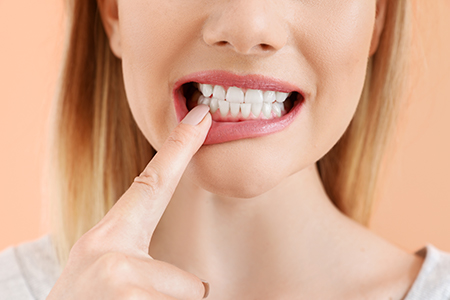New Patients
Existing Patients


Gum disease is a leading cause of tooth loss for adults, and many people don’t realize their gums are at risk until the condition has advanced. Studies show periodontal disease affects a large portion of adults, so understanding how it begins and how it is treated can protect your smile and overall health. At the office of Joanna Tricorache, DDS, we provide careful evaluation and a range of treatment options designed to preserve natural teeth and restore strong, healthy gum support.
Periodontal disease begins when bacteria living in dental plaque trigger an inflammatory response in the gums and the supporting tissues around the teeth. Left unchecked, that inflammation can break down the fibers and bone that hold teeth in place. The condition ranges from mild, reversible inflammation to more destructive stages that threaten tooth stability.
Ongoing accumulation of plaque and tartar beneath the gumline creates an environment where bacteria multiply and produce toxins. The body’s immune response to these bacteria produces inflammation that, over time, harms the soft tissue and the jawbone. Because early stages can be painless, many people discover the problem only after more obvious signs appear.
Recognizing the mechanisms behind periodontal disease helps patients appreciate why prevention, timely detection, and appropriate treatment are so important. By addressing the bacterial cause and supporting tissue healing, dentists can often stop progression and restore a healthier foundation for the teeth.
Regular professional assessments are the best way to catch the disease early. During an exam, your dental team measures pocket depths, evaluates gum attachment, and looks for bone changes so a tailored plan can be developed.
Healthy gums do more than keep your smile looking good; they play a role in your overall health. Research increasingly links chronic oral inflammation with systemic conditions such as cardiovascular disease, diabetes control, and respiratory health. Managing periodontal disease can reduce chronic inflammation and support better health outcomes beyond the mouth.
Keeping gingival inflammation under control also makes everyday routines—eating, speaking, and maintaining oral hygiene—easier and more comfortable. When gum tissue is stable, patients experience fewer interruptions to daily life from pain, sensitivity, or dental complications.
At the office of Joanna Tricorache, DDS, our emphasis is on prevention, early intervention, and clear patient education. We work with each patient to establish realistic home care practices and an appropriate schedule for professional care so periodontal concerns are addressed before they become advanced problems.
Gingivitis is the earliest stage of gum disease and is usually reversible with improved oral hygiene and professional care. Common indicators include redness, swelling, tenderness, and bleeding during brushing or flossing. Because these symptoms can be subtle, many people assume minor bleeding is normal rather than a sign that bacteria are irritating the gums.
Left untreated, gingivitis can progress to forms of periodontal disease that affect the bone and attachments around teeth. Catching and treating gingivitis promptly prevents the tissue destruction that leads to deeper pockets and tooth mobility. Simple interventions at this stage are often highly effective.
Treatment for early-stage disease focuses on removing plaque and calculus, reducing bacterial levels, and reinforcing daily habits that limit re-accumulation. With a consistent maintenance plan, many patients return to stable gum health and avoid the need for more invasive procedures down the road.

Periodontitis describes the stage of disease in which the structures that support teeth—gum fibers and jawbone—are actively being lost. As pockets deepen between the tooth and gum, bacteria become harder to remove with routine brushing and even some professional cleanings. The result is progressive attachment loss and, in severe cases, tooth loss.
Treatment in this phase aims to arrest the disease process, reduce pocket depths, and preserve as much natural support as possible. Approaches vary depending on the extent of tissue loss but commonly include targeted cleaning below the gumline, antimicrobial strategies, and in selected cases, surgical intervention to reshape or regenerate damaged tissues.
Managing periodontitis is a collaborative effort: clinical therapies reduce the microbial burden and create a healthier environment, while patient commitment to daily home care and periodic maintenance visits sustains improvements over time.

Advances in periodontal care allow clinicians to tailor treatment based on disease severity and patient needs. In many cases, less invasive therapies are effective at controlling disease and preventing further damage. When tissue has been lost, regenerative procedures and grafting techniques can rebuild volume and improve support for teeth or future implant restorations.
Beyond mechanical cleaning, adjunctive measures—such as localized antimicrobial delivery or systemic therapy when indicated—help control the bacterial component of the disease. Laser-assisted procedures may be appropriate in selected situations to reduce pocket depth and promote healing with minimal discomfort.
Each treatment plan is individualized, taking into account medical history, the extent of periodontal involvement, and the patient’s oral hygiene capabilities. The goal is always to re-establish a healthy, maintainable environment that preserves teeth and enhances oral comfort and function.
Your care begins with a comprehensive periodontal evaluation that includes pocket measurements, a review of medical history, and imaging when needed. From there, we outline the steps recommended to control disease and restore periodontal stability. Communication is central: we explain why each procedure is recommended and what you can expect during recovery.
Short-term goals focus on infection control and reducing inflammation. Long-term goals target the preservation of bone and connective tissue, preventing recurrence, and maintaining a predictable maintenance schedule. Many patients transition from active treatment to a personalized maintenance program designed to keep the disease from returning.
Our team is available to answer questions throughout treatment and to guide patients through each phase—from initial non-surgical care to any surgical or regenerative measures that are necessary for durable results.

When disease is detected early or confined to shallow pockets, conservative care is often effective. Scaling and root planing remove plaque and hardened deposits beneath the gumline and smooth root surfaces so the tissue can reattach more easily. Improved daily hygiene and professional maintenance visits are essential components of long-term success.
Adjuncts to non-surgical care may include antimicrobial agents placed under the gums or prescribed systemic medications in cases where bacterial control is especially challenging. The combination of clinical therapy and consistent home care can stabilize many patients without the need for surgery.
Regular periodontal maintenance after active therapy is a cornerstone of preventing recurrence. That maintenance schedule is personalized and based on your response to treatment and ongoing risk factors.
In advanced cases, surgery may be indicated to access deep pockets, reduce pocket depth, and reshape or regenerate damaged tissue. Flap procedures permit thorough cleaning of root surfaces and may be combined with grafting or regenerative materials to encourage new attachment and bone fill where appropriate.
Modern periodontal surgery aims to minimize trauma while maximizing the potential for tissue recovery. Techniques are chosen to restore function, improve the ability to maintain cleanliness, and reduce the risk of future breakdown.
Surgical treatment can also address cosmetic concerns related to gum recession and restore a more natural gum line when possible, always with an eye toward long-term stability.
Remove bacterial deposits beneath the gums and on root surfaces
Halt further damage to the underlying bone and reshape hard tissue where needed
Reduce pocket depths to make daily oral hygiene and professional upkeep more effective
Periodontal health is central to a confident, functional smile. If you are concerned about bleeding gums, persistent bad breath, loose teeth, or any other signs of gum disease, reach out to our team to learn more about how we assess and treat periodontal conditions. Contact us for more information and to discuss the next steps for your care.

Most people don’t realize that periodontal disease is the leading cause of tooth loss among adults. According to statistics from the Centers for Disease Control and Prevention, one out of every two adults over the age of 30 in the United States has periodontal disease.
You may be surprised to learn that the human mouth is home to a wide variety of microbes. The fact is that over 700 different strains of bacteria have been detected in the oral cavity. Although some of these bacteria are beneficial, others are harmful to oral health. Without proper oral hygiene and routine dental care, these harmful bacteria can cause tooth decay and gum disease, compromising both your oral health and overall wellbeing.
In addition to inadequate oral hygiene and infrequent professional care, other factors, including smoking, genetic tendencies, and unchecked diabetes, can contribute to the escalation of periodontal disease.
Your gums and teeth have an interdependent relationship, which means healthy teeth depend on the support of healthy gums. Also, taking care of your smile does more than keep your teeth and gums in optimal condition; good oral health also supports systemic health. In addition to being the leading cause of tooth loss in adults, researchers are finding more and more links between periodontal disease and a number of medical problems, including heart disease, stroke, diabetes, respiratory problems, and adverse pregnancy outcomes such as pre-term and low birth-weight babies.
If you notice that your gums are bleeding with the slightest pressure while brushing or flossing, it’s a sign of gingivitis. Although gingivitis is the earliest stage of gum disease, it can easily be reversed with deeper cleanings as well as an improved regimen of oral hygiene at home.
In the absence of professional treatment and better home care, gingivitis progresses to the next stage, which is known as periodontitis. In this stage, the connective tissue and bone that hold the teeth in place begin to break down with an increase in pocketing between the teeth and bone, gum recession, and bone loss. Without proper treatment by your dentist, periodontitis will progress from a mild to moderate loss of supporting tissue to the destruction of the bone around the teeth.
Although gingivitis can often be reversed with improved oral hygiene and professional cleanings, as periodontal disease advances, more extensive procedures are required to halt its progression. Based on a complete assessment of your periodontal health and a review of possible contributing factors, our office will recommend the best options in care. Treatment for periodontitis may include a series of deeper cleanings known as root planing and scaling, surgical procedures to reduce pocket depth, bone or tissue grafts, laser procedures, or antimicrobial medications.
The cost of care depends on the type of procedures required to restore your periodontal health. If you have dental insurance, plans often cover treatment to prevent gum disease as well as many procedures to treat the various stages of gum disease. Our goal is to help patients restore and maintain good oral health. We do all we can to help you begin care without additional stress or delay. Our business office works with you to maximize your benefits and provide easier, more convenient payment options.
By seeing our office regularly for care and doing your best to eat a healthy diet and practice good oral hygiene, you can keep your smile in tip-top shape as well as protect your overall wellbeing.
At the office of Joanna Tricorache, DDS, we provide a comprehensive range of services to address all your oral healthcare needs. You can rest assured that your smile is in the best of hands at our office. Our skilled and experienced team maintains a position at the forefront of advances in care and remains dedicated to providing the highest quality of skilled and compassionate treatment.

Ready to schedule your next dental appointment or have questions about our services?
Contacting Joanna Tricorache, DDS is easy! Our friendly staff is available to assist you with scheduling appointments, answering inquiries about treatment options, and addressing any concerns you may have. Whether you prefer to give us a call, send us an email, or fill out our convenient online contact form, we're here to help. Don't wait to take the first step towards achieving the smile of your dreams – reach out to us today and discover the difference personalized dental care can make.